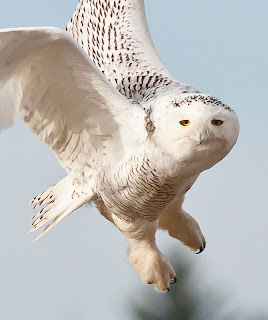
There is not much vegetation in the arctic tundra, so instead of searching for trees these birds simply nest on the ground.
Snowy owl wingspan full#
Sometimes, though, the birds struggle to navigate developed landscapes full of buildings and telephone wires. That includes the Snowy found gnawing on a bottle-nosed dolphin carcass in Delaware a few years ago, fending off its find from Turkey Vultures. In reality, these Snowy Owls are fairly fat and healthy, says Weidensaul, and will eat anything they find. People often assume that if they see an Arctic bird in, say, Indiana, it must be sick or starving. No matter how many ultimately show up, these birds are tough.

Without an estimate of recent clutch sizes, SNOWstorm can’t predict how big this inundation could be. According to Weidensaul, nests held eight or nine eggs each in 2013-far more than the typical three to four. Those unusually large clutches contributed to the impressive numbers from a few years ago. Part of the uncertainty in predicting this year’s potential irruption stems from the lack of people monitoring Snowy Owl nests in the wilderness of northern Quebec. When more of the species catch up, SNOWstorm volunteers will know for sure if the irruption is bona fide, and where it will hit hardest. A couple hundred have flocked to the Northeast and Upper Midwest, Weidensaul says-single birds have been spotted as far south as Oklahoma, Missouri, and North Carolina-and their numbers are building faster than they did in 2013. Sure enough, this past breeding season, Canadian wildlife biologists studying caribou reported an unusually high number of owls flapping around the same area, reports others have confirmed.Įarly stateside migrators have also been spotted. That's because lemmings, their preferred prey, go through regional population explosions at about the same interval. In 2013, those little Arctic rodents had a banner year on the Ungava Peninsula in Northern Quebec, fueling a highly successful breeding season for the owls that flocked to that area. Data are sketchy and variable, but it appears that big southward movements occur about once every four years. Though Snowy Owl migration patterns are mostly mysterious, there have been some tell-tale signs that the birds are on their way.įor one, some Snowy Owls already seem to be retracing the last irruption’s process. “There’s a little bit of voodoo and black magic in all of this,” Weidensaul says. Scott Weidensaul, one of the directors of Project SNOWstorm, says the clues point to a big irruption, but the group also fully admits there's no way to definitively know how big it could be or if it will even happen at all.

Project SNOWstorm, a volunteer-fueled Snowy Owl-tracking organization founded after that irruption, predicts another wave of Arctic raptors will hit North America this winter, according to their most recent blog post. They were part of the largest Snowy Owl irruption, or influx of a species into a place they don’t usually live, the U.S. In a typical winter, around 10 Snowies visit Pennsylvania, but in 2013 the state was graced by 400. Some whiled away the hours peering at dog walkers from suburban fences one learned to hunt around a Minnesota brewery with mouse problems. Four years ago, thousands of Snowy Owls stormed the northern United States, taking up posts in surroundings drastically different from the flat Arctic tundra over which they typically preside.


 0 kommentar(er)
0 kommentar(er)
